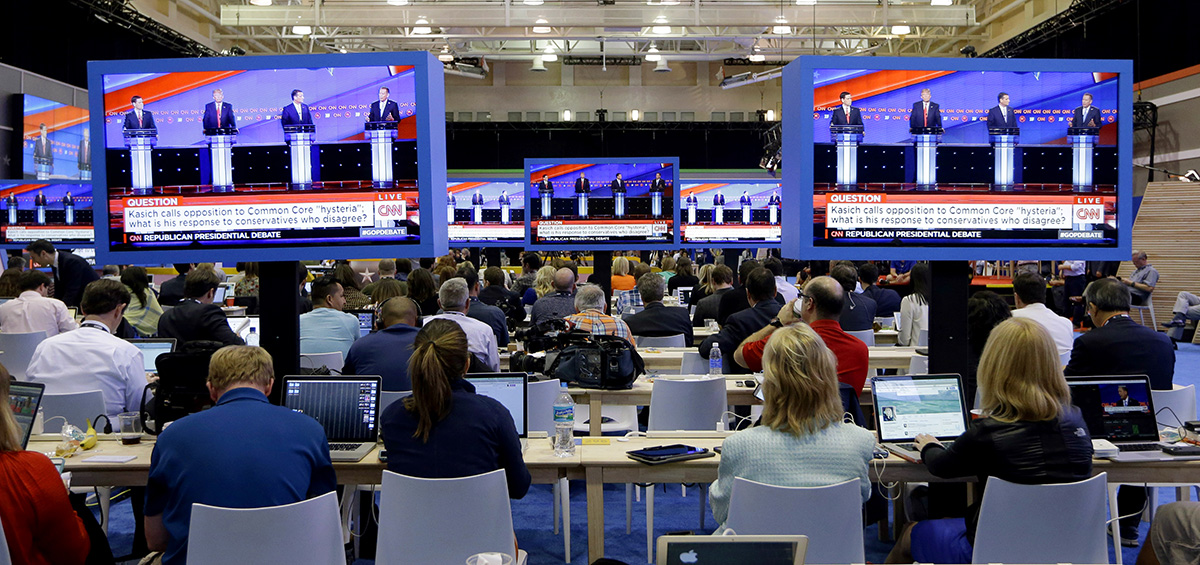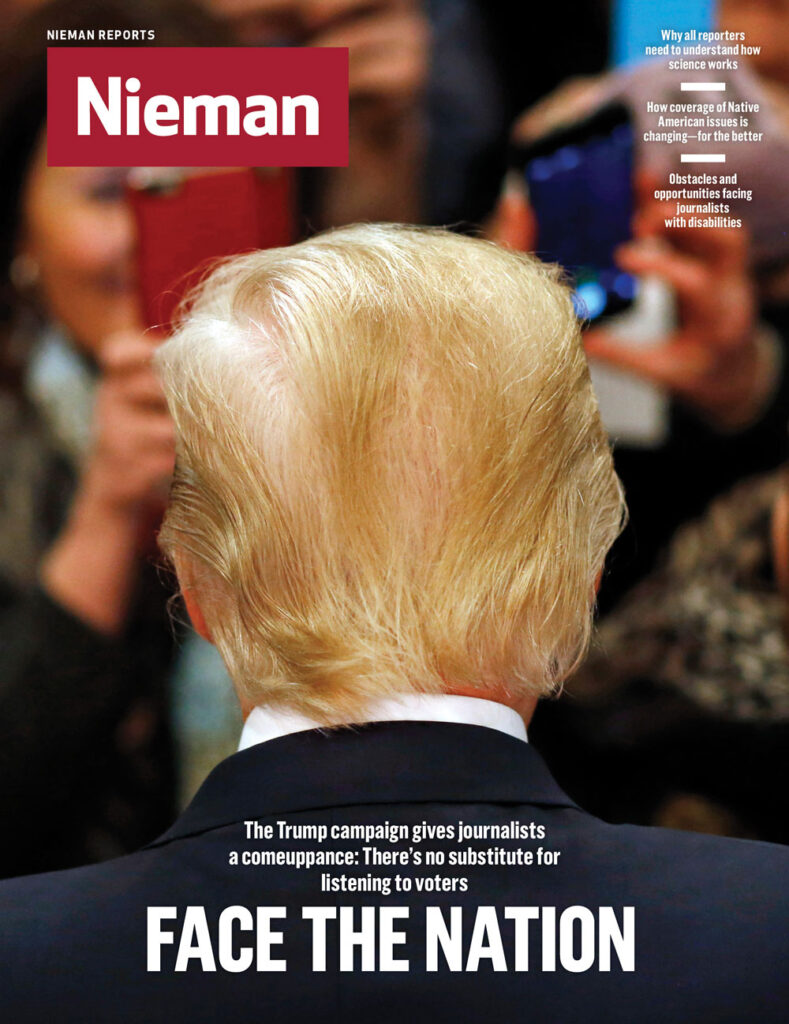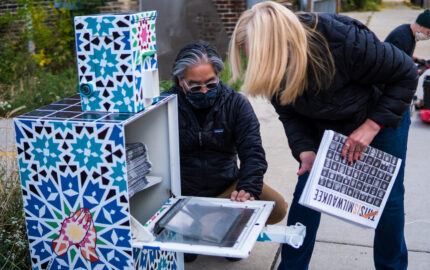In awarding its Lie of the Year title to Donald Trump last December, the staff at PolitiFact had a lot of material from which to choose.
During the first GOP debate on August 6 in Cleveland, Ohio, the front-runner for the Republican presidential nomination said the government of Mexico sends “the bad ones over,” referring to the undocumented immigrants entering the U.S. from that country. There is nothing to suggest the Mexican government encourages criminals to enter the U.S.
On November 21 in Birmingham, Alabama, Trump claimed “thousands of people were cheering” in Jersey City, New Jersey as the World Trade Center towers collapsed on September 11, 2001. There is no evidence for this claim, and Trump has not put forth any to support it.
On November 22, Trump retweeted an image that contained the following statistics: “Whites killed by whites—16%. Whites killed by blacks—81%.” FBI statistics show that in 2014, 82 percent of white murder victims were killed by whites, and the number of whites killed by blacks was approximately 15 percent.
“We did have a long discussion about if there was one [lie] that was more significant than the other, but at the end of the discussion it just seemed like it was a tough call,” says Angie Drobnic Holan, editor of PolitiFact, the 2009 Pulitzer Prize-winning fact-checking wing of The Tampa Bay Times. “They were all pretty inaccurate and inflammatory.” So PolitiFact ended up designating Trump’s collective falsehoods as Lie of the Year rather than singling out one as especially egregious.
Campaign seasons are always busy times for fact-checkers, but this presidential campaign has been particularly intense. According to the Reporters’ Lab at Duke University, there are 96 active fact-checking projects in the U.S. and abroad, up by 50 percent since last year. And many are using advanced technologies to automate and accelerate the process. “The key to the future of fact-checking is getting the fact-checks virtually instant and making it so the fact-check is presented on the medium that the claim is made on,” says Bill Adair, director of The Reporters’ Lab and founder of PolitiFact.
Research suggests that people do care about the facts—sort of. An American Press Institute (API) study, which measured public views on fact-checking during the 2014 campaign season, found that nearly half of those surveyed were somewhat or very unfamiliar with the practice. Those who were more familiar with fact-checking had more favorable attitudes toward it, as did individuals well informed about politics more generally, especially Democrats. The API study, released last spring, found that 59 percent of politically well-informed Democrats had very favorable views of fact-checkers, versus 34 percent of well-informed Republicans. For less politically well-informed Democrats, 36 percent considered fact-checkers favorably, compared to 29 percent of less well-informed Republicans.
Fact-checking is increasingly being bolstered by tools like ClaimBuster, an automated platform designed to help identify which claims by politicians should be checked. A collaborative project among journalists, academics, and computer scientists from the University of Texas at Arlington, Duke University (including Adair), Google Research, and The Dallas Morning News, ClaimBuster is programmed to give political statements a check-worthiness rating that flags which ones merit verification. During the Democratic and Republican debates, the ClaimBuster team has fed closed-captioning text into the prototype, and posted some of the most check-worthy statements on Twitter. While the system now only identifies statements, researchers hope ClaimBuster will eventually be able to monitor live streams, social media feeds, and websites to not just instantaneously detect factual claims but also to match identified statements with a repository of existing fact-checks from outlets like PolitiFact and FactCheck.org.
The nonprofit digital library Internet Archive is also working to advance fact-checking. Its searchable Political TV Ad Archive uses algorithms to identify and categorize political advertisements in 20 markets, including those in Florida, Iowa, Ohio, and Virginia, and make them available to fact-checkers, as well as others interested in the material.
The Archive has partnered with the Reporters’ Lab at Duke, The Washington Post’s Fact Checker, FactCheck.org, and the Center for Public Integrity to scrutinize political ads from the 2016 primary season, and, to date, outlets ranging from Fusion to Fox News have used the data in stories. Andrew McGill, senior associate editor at The Atlantic, and colleagues mined the archive to visualize an average Iowan’s television screen on January 29, two days before the caucuses, when an average of one ad aired every 45 seconds.
At Duke, Adair is also developing Share the Facts, a widget allowing journalists, bloggers, and columnists to embed summaries of fact-checks in their articles the way they can already embed tweets. A recent post on PolitiFact’s North Carolina site, run in partnership with The News & Observer in Raleigh, rated as “Half True” Trump’s statement that NASCAR had endorsed him. While he did receive the endorsement of its CEO, NASCAR itself did not endorse Trump. The posting included the embeddable widget, showing Trump’s remark, the date and occasion on which the claim was made, and PolitiFact’s veracity rating, which ranges from “True” to “Pants on Fire” false.
Michelle Ye Hee Lee, a reporter on The Fact Checker at The Washington Post, is extending fact-checking to Snapchat. Because Snapchat prioritizes images over text, Lee selects fact-checks that can be quickly explained without a lot of prose. For example, when Ted Cruz claimed during the March 3 GOP debate that he spent much of his life in law enforcement, Lee posted Cruz’s claim above an illustration of the candidate. When users swiped right, they saw the Post’s brief debunk of Cruz’s claim: “not rly … He’s exaggerating. He was a lawyer for Texas & defended criminals in private practice.” Snapchat fact-checks like these have garnered the most views of any Post political story on the platform.
As journalists and computer scientists work to refine and streamline the process, Adair thinks the growth of the practice marks “a wonderful moment in accountability journalism. Fact-checking provides a critical service to democracy that many, many people do, in fact, rely on to shape what they believe to be true.”
With reporting by Eryn M. Carlson
During the first GOP debate on August 6 in Cleveland, Ohio, the front-runner for the Republican presidential nomination said the government of Mexico sends “the bad ones over,” referring to the undocumented immigrants entering the U.S. from that country. There is nothing to suggest the Mexican government encourages criminals to enter the U.S.
On November 21 in Birmingham, Alabama, Trump claimed “thousands of people were cheering” in Jersey City, New Jersey as the World Trade Center towers collapsed on September 11, 2001. There is no evidence for this claim, and Trump has not put forth any to support it.
On November 22, Trump retweeted an image that contained the following statistics: “Whites killed by whites—16%. Whites killed by blacks—81%.” FBI statistics show that in 2014, 82 percent of white murder victims were killed by whites, and the number of whites killed by blacks was approximately 15 percent.
“We did have a long discussion about if there was one [lie] that was more significant than the other, but at the end of the discussion it just seemed like it was a tough call,” says Angie Drobnic Holan, editor of PolitiFact, the 2009 Pulitzer Prize-winning fact-checking wing of The Tampa Bay Times. “They were all pretty inaccurate and inflammatory.” So PolitiFact ended up designating Trump’s collective falsehoods as Lie of the Year rather than singling out one as especially egregious.
Campaign seasons are always busy times for fact-checkers, but this presidential campaign has been particularly intense. According to the Reporters’ Lab at Duke University, there are 96 active fact-checking projects in the U.S. and abroad, up by 50 percent since last year. And many are using advanced technologies to automate and accelerate the process. “The key to the future of fact-checking is getting the fact-checks virtually instant and making it so the fact-check is presented on the medium that the claim is made on,” says Bill Adair, director of The Reporters’ Lab and founder of PolitiFact.
Research suggests that people do care about the facts—sort of. An American Press Institute (API) study, which measured public views on fact-checking during the 2014 campaign season, found that nearly half of those surveyed were somewhat or very unfamiliar with the practice. Those who were more familiar with fact-checking had more favorable attitudes toward it, as did individuals well informed about politics more generally, especially Democrats. The API study, released last spring, found that 59 percent of politically well-informed Democrats had very favorable views of fact-checkers, versus 34 percent of well-informed Republicans. For less politically well-informed Democrats, 36 percent considered fact-checkers favorably, compared to 29 percent of less well-informed Republicans.
Fact-checking is increasingly being bolstered by tools like ClaimBuster, an automated platform designed to help identify which claims by politicians should be checked. A collaborative project among journalists, academics, and computer scientists from the University of Texas at Arlington, Duke University (including Adair), Google Research, and The Dallas Morning News, ClaimBuster is programmed to give political statements a check-worthiness rating that flags which ones merit verification. During the Democratic and Republican debates, the ClaimBuster team has fed closed-captioning text into the prototype, and posted some of the most check-worthy statements on Twitter. While the system now only identifies statements, researchers hope ClaimBuster will eventually be able to monitor live streams, social media feeds, and websites to not just instantaneously detect factual claims but also to match identified statements with a repository of existing fact-checks from outlets like PolitiFact and FactCheck.org.
The nonprofit digital library Internet Archive is also working to advance fact-checking. Its searchable Political TV Ad Archive uses algorithms to identify and categorize political advertisements in 20 markets, including those in Florida, Iowa, Ohio, and Virginia, and make them available to fact-checkers, as well as others interested in the material.
The Archive has partnered with the Reporters’ Lab at Duke, The Washington Post’s Fact Checker, FactCheck.org, and the Center for Public Integrity to scrutinize political ads from the 2016 primary season, and, to date, outlets ranging from Fusion to Fox News have used the data in stories. Andrew McGill, senior associate editor at The Atlantic, and colleagues mined the archive to visualize an average Iowan’s television screen on January 29, two days before the caucuses, when an average of one ad aired every 45 seconds.
At Duke, Adair is also developing Share the Facts, a widget allowing journalists, bloggers, and columnists to embed summaries of fact-checks in their articles the way they can already embed tweets. A recent post on PolitiFact’s North Carolina site, run in partnership with The News & Observer in Raleigh, rated as “Half True” Trump’s statement that NASCAR had endorsed him. While he did receive the endorsement of its CEO, NASCAR itself did not endorse Trump. The posting included the embeddable widget, showing Trump’s remark, the date and occasion on which the claim was made, and PolitiFact’s veracity rating, which ranges from “True” to “Pants on Fire” false.
Michelle Ye Hee Lee, a reporter on The Fact Checker at The Washington Post, is extending fact-checking to Snapchat. Because Snapchat prioritizes images over text, Lee selects fact-checks that can be quickly explained without a lot of prose. For example, when Ted Cruz claimed during the March 3 GOP debate that he spent much of his life in law enforcement, Lee posted Cruz’s claim above an illustration of the candidate. When users swiped right, they saw the Post’s brief debunk of Cruz’s claim: “not rly … He’s exaggerating. He was a lawyer for Texas & defended criminals in private practice.” Snapchat fact-checks like these have garnered the most views of any Post political story on the platform.
As journalists and computer scientists work to refine and streamline the process, Adair thinks the growth of the practice marks “a wonderful moment in accountability journalism. Fact-checking provides a critical service to democracy that many, many people do, in fact, rely on to shape what they believe to be true.”
With reporting by Eryn M. Carlson




